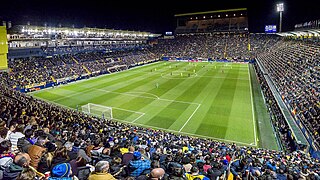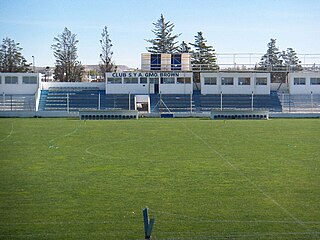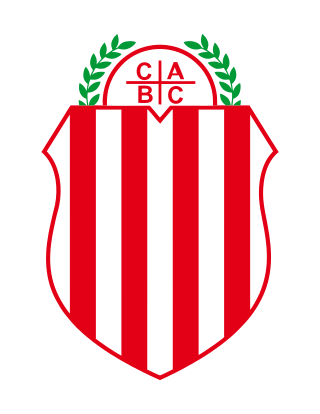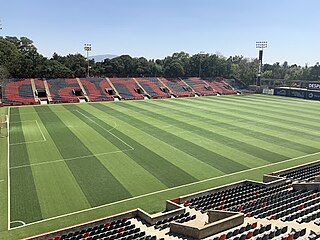
The Estadio Víctor Manuel Reyna is a football stadium located in Tuxtla Gutierrez, Chiapas, México. This facility has a capacity of 29,001 seats and was built in 2003. This sport facility is used mostly for football matches and is currently the home stadium for Cafetaleros de Chiapas. It also hosted shows as the final of La Academia Última Generación.

The Estadio Tamaulipas is a football stadium in the southern portion of the Mexican state of Tamaulipas, serving as the home of C.D.S. Tampico Madero It sits across two municipalities, Tampico and Ciudad Madero, and has a capacity of 19,667. The center line of the stadium sits on the municipal boundary.

The Estadio Cuscatlán is a football stadium located in the city of San Salvador, El Salvador. It was inaugurated in 1976. It can hold 53,400 spectators, making it the Association Football stadium with the largest spectator capacity in Central America and the Caribbean. The stadium has undergone several renovations, including in 1997; 2007; 2008; 2015, with the change of colors alluding to the country's flag ; and the most recent in 2020, with the installation of a new screen 100m² 4K LED and 54 new 1,500-watt metal halide luminaires with a capacity of 1,000 luxes, and an automated irrigation system.

Estadio de la Cerámica, formerly and informally called El Madrigal, is a football stadium in Villarreal, Spain, used since 1923. It is currently the home venue of Villarreal CF of La Liga, the highest football league in Spain.

The Estadio Cachamay is part of the Centro Total de Entretenimiento Cachamay. It is a multipurpose stadium located on Avenida Guayana in Puerto Ordaz Bolivar State, Venezuela. The old stadium was opened in 1980 and subjected to an expansion, modernization and remodeling over the years 1990 and 2006–2007, which involved the demolition of some parts and redesign of its structure to point to double its capacity before 2006, being one of the 9 host stadiums of the 2007 Copa América, when it reopened as Cachamay CTE. It is set in grounds with beautiful natural landscapes, surrounded by the mighty river Caroni and waterfalls Cachamay Park. The sports center is managed by the Cachamay Foundation, with home court advantage for soccer teams AC Mineros de Guayana and AC Minervén FC Bolivar. The CTE is known popularly as Cachamay Stadium.

Estadio Raúl Conti is a stadium in Puerto Madryn, Argentina. Inaugurated on May 25, 1967, it is the home venue of local club Guillermo Brown. The stadium has a capacity for 15,000 spectators.

Club Tijuana Xoloitzcuintles de Caliente, commonly known as Tijuana, or simply as Xolos, is a Mexican professional football club based in Tijuana, Baja California, Mexico. The club's badge is the founder's hairless xoloitzcuintle, Hermoso.

Club Atlético Barracas Central is an Argentine football club from the district of Barracas, Buenos Aires. Established in 1904, Barracas Central will return to the Primera División, the top level of the Argentine football league system, in the 2022 season after the team won the Torneo Reducido.

Club de Fútbol Correcaminos de la Universidad Autónoma de Tamaulipas, simply known as Correcaminos UAT, is a Mexican professional football club based in Ciudad Victoria, Tamaulipas.
Estadio Carlos Vega Villalba, formerly known as the Estadio Francisco Villa is a multi-use stadium in Zacatecas, Zacatecas, Mexico. It is used mostly for football matches and is the home stadium for the new Ascenso MX side Mineros de Zacatecas. The stadium has a capacity of 20,068 people.

Altamira Fútbol Club, or Estudiantes de Altamira was a Mexican football team based in Altamira, Tamaulipas.

The Estadio José Fierro is a multi-use stadium in the city of San Miguel de Tucumán in Tucumán Province, Argentina. It is the home ground for Club Atlético Tucumán. The stadium's capacity is now 35,200 due to extensive remodeling of the stadium.
The Copa 2012 MX Apertura was the 68th staging of the Copa MX football tournament, the 41st staging in the professional era and the first played since the 1996–97 edition.
The Copa 2013 MX Clausura was the 69th staging of the Copa MX, the 42nd staging in the professional era and is the second tournament played since the 1996–97 edition.
The Copa 2014 MX Clausura was the 71st staging of the Copa MX, the 44th staging in the professional era and is the fourth tournament played since the 1996–97 edition.
The 2013–14 Ascenso MX season took place from 19 July 2013 to 12 April 2014 and was divided into two tournaments named Apertura 2013 and Clausura 2014. The Ascenso MX is the second-tier football league of Mexico.

Club de Fútbol Cafetaleros de Chiapas is a Mexican football club based in the city of Tuxtla Gutiérrez, Chiapas currently competing in Liga Premier de México, the third tier of Mexican football. Between 2015 and 2020, the team played at Ascenso MX, the second tier of Mexican football. On June 26, 2020, the club's first-team squad was relocated to Cancún and renamed as Cancún F.C., however, Cafetaleros de Chiapas kept the team registered in Liga Premier, which was affiliated with Cancún F.C. between 2020 and 2022.

The Stadium Gregorio "Tepa" Gómez is a multi-use stadium in Tepatitlán de Morelos, Jalisco, Mexico. It is currently used mostly for football matches and is the home stadium for Tepatitlán FC. The stadium has a capacity of 8,085 people.
Gimnástico F.C. is a Honduran football club located in Tegucigalpa. They currently play in the Liga de Ascenso and they play their home games at Estadio Emilio Larach, located in La Kennedy neighborhood.

Estadio Borregos, also referred to as Estadio Banorte for sponsorship reasons, is a multi-purpose stadium in Monterrey, Mexico. It is the home stadium for the college football team Borregos Salvajes Monterrey of the ONEFA and the professional American football team Fundidores de Monterrey from the Liga de Fútbol Americano Profesional. The stadium was inaugurated in April 2019 and seats 10,057 spectators.














